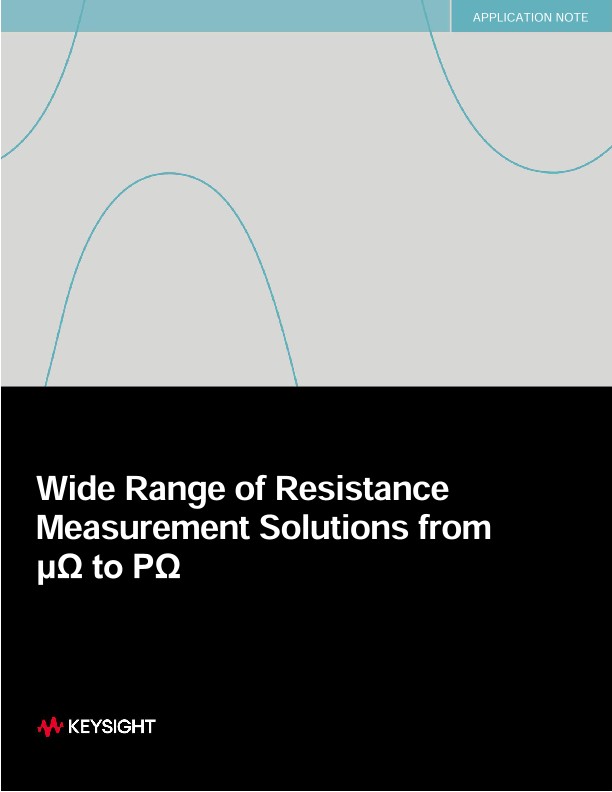
Wide Range of Resistance Measurement Solutions from µ? to P?
Application Notes
Introduction
Resistance measurement is one of the fundamental characterizations of materials, electronic devices, and circuits. Although there are a variety of resistance measurements used throughout the world, we make the most of the convenience of digital multimeters (DMMs).
At first glance, resistance measurement appears to be simple and easy to use, since it is merely a combination of sourcing and measuring voltage or current based on Ohm’s law. However, there are in fact a variety of error factors that prevent us from taking an accurate resistance measurement. At the same time, the factors that affect measurement results differ among the measurement resistance range. It is therefore vital to select appropriate instruments according to the characteristics of the device under test (DUT) to acquire reliable measurement results. Keysight Technologies, Inc. offers a variety of resistance measurement solutions that cover resistance from μΩ to PΩ, providing you with the best choice to meet your resistance measurement needs.
Table of contents
Keysight resistance measurement solutions
- Versatile resistance measurement solutions
- Low resistance measurement solutions
- High resistance measurement solutions
Major error factors in resistance measurements
- Lead resistance
- Thermal electromotive force (EMF)
- Power dissipation effects
- Output voltage clamping
- Settling time effects
- Leakage current
Keysight Versatile resistance measurement solutions
Due to their convenience, DMMs are commonly used to make resistance measurements. Keysight offers a wide variety of DMMs such as handhelds and bench-top instruments. This allows you to select a model to suit your measurement requirements and usage environment. Since most DMMs only use an auto resistance measurement mode, the test current is essentially fixed for each range. Handheld DMMs generally only support 2-wire connections, while most bench-top DMMs support 2-wire and 4-wire connections.
Keysight also offers Keysight B2900A precision source/measure units (SMUs) providing a versatile resistance measurement solution that covers currents from 10 fA to 3 A (DC)/10.5 A (pulse) and voltages from 100 nV to 210 V. The SMU combines the capabilities of the current source, voltage source, current meter, and voltage meter along with the capability to switch easily between these various functions within a single instrument.
This gives you the ability to evaluate the current-voltage (IV) characteristics including resistance for devices without the need for any additional equipment. As well as the ability to output and measure voltage or current with a high degree of accuracy, SMUs also possess a compliance feature that allows a limit to be placed on the voltage or current output to prevent device damage.
It is essential to use a 4-wire connection configuration in low resistance measurements because the residual lead resistance is comparable to the DUT resistance. A 4-wire measurement, which is available with the B2900A Series as well as most bench-top DMMs, uses one pair of leads to source the current and the other pair of leads to measure voltage. This eliminates cable resistance effects so that only the voltage drop across the DUT is measured.
Keysight low resistance measurement solutions
The Keysight 34420A 7 ½ digit nano volt/micro ohmmeter is a high-sensitivity multimeter optimized for performing low-level measurements. It combines low-noise voltage measurements with resistance and temperature functions, setting a new standard in low-level flexibility and performance. It covers a range of resistance measurements from 1 Ohm to 1 M ohm.
Certain types of resistance measurements require a very precise, low-level current source to prevent device self-heating or device damage during testing. In general, accuracy improves with the magnitude of the voltage or current being measured. Therefore, for devices with low resistance values, it is important to keep the measurement voltage as large as possible. The Keysight B2960A series 6.5 digit low noise power source satisfies these measurement requirements when used in combination with the 34420A.
The B2960A series is an advanced bipolar power supply/source and can source either voltage or current with 6.5 digits of resolution while also monitoring both voltage and current, allowing it to make a resistance measurement by itself.
The combination of the B2961A and 34420A provides superior performance for low resistance measurements. In the resistance measurement scheme shown in Figure 7, the 34420A performs the voltage measurement while the B2961A sources a precise current. In this configuration, the B2961A acts as the master and makes measurements at programmed intervals while simultaneously sending trigger signals to the 34420A to perform voltage measurements.